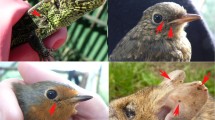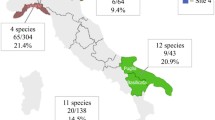Abstract
Tick-transmitted diseases like tick-borne encephalitis and Lyme Borreliosis have been well known in Germany for decades. Global climate changes may influence the emergence and reemergence of diseases. Ongoing research now gives an additional focus on other tick-borne pathogens such as Coxiella burnetii, Rickettsia conorii, Anaplasma phagocytophilum and Babesia spp., the causative agents of Q-fever, Mediterranean spotted fever, Anaplasmosis and Babesiosis, respectively. The epidemiology of these pathogens was investigated on ticks as well as on rodents, the main hosts. Therefore adults of Dermacentor spp. (n = 862) and rodents (n = 119) were collected and examined for the existence of C. burnetii and Rickettsia spp. by polymerase chain reaction (PCR). In none of the ticks and rodents C. burnetii could be detected, in contrast to Rickettsia spp. where the infection rate in ticks was about 20%. Over and above that, nymphs and adults of Ixodes ricinus were also collected and investigated by PCR for A. phagocytophilum (n = 5,424), Rickettsia helvetica (n = 1,187) and Babesia spp. (n = 3,113). Thereby infection rates of 1%, 8.9% and 1%, respectively, could be determined. The prevalence in rodents was 5.3% for A. phagocytophilum and 0.8% for Babesia microti. None of the rodents was R. helvetica positive.



Similar content being viewed by others
References
Bjoersdorff A, Berglund J, Kristiansen BE, Soderstrom C, Eliasson I (1999) Varying clinical picture and course of human granulocytic ehrlichiosis. Twelve Scandinavian cases of the new tick-borne zoonosis are presented (Abstr.). Lakaridningen 96:4200–4204
Boom R, Sol CJ, Salimans MM, Jansen CL, Wertheim-van Dillen PM, van der Noordaa J (1990) Rapid and simple method for purification of nucleic acids. J Clin Microbiol 28:495–503
Burgdorfer W, Aeschlimann A, Peter O, Hayes SF, Philip RN (1979) Ixodes ricinus vector of a hitherto undescribed spotted fever group agent in Switzerland. Acta Trop 36:357–367
Burkot TR, Schneider BS, Pieniazek NJ, Happ CM, Rutherford JS, Slemenda SB, Hoffmeister E, Maupin, Z, eidner NS (2000) Babesia microti and Borrelia bissetti transmission by Ixodes spinipalpis ticks among prairie voles, Microtus ochrogaster, in Colorado. Parasitology 121:595–599
Christova I, Dumler JS (1999) Human granulocytic ehrlichiosis in Bulgaria. Am J Trop Med Hyg 60:58–61
Christova I, van de Pol J, Yazar S, Velo E, Schouls L (2003) Identification of Borrelia burgdorferi sensu lato, Anaplasma and Ehrlichia species, and spotted fever group Rickettsiae in ticks from south-eastern Europe. Eur J Clin Microbiol Infect 22:535–542
Cinco M, Padovan D, Murgia R, Maroli M, Frusteri L, Heltander M, Johansson KE, Engvall EO (1997) Coexistence of Ehrlichia phagocytophila and Borrelia burgdorferi sensu lato in Ixodes ricinus ticks from Italy as determined by 16S rRNA gene sequencing. J Clin Microbiol 35:3365–3366
Dezfuli M (2006) Untersuchungen zur Epidemiologie von Coxiellen und Rickettsien in Dermacentor-Zecken. Diplomarbeit im Studiengang Biologie der Eberhard-Karls-Universität Tübingen
Fingerle V, Goodman JL, Johnson RC, Kurtti TJ, Munderloh UG, Wilske B (1997) Human granulocytic ehrlichiosis in southern Germany: increased seroprevalence in high-risk groups. J Clin Microbiol 35:3244–3247
Frangoulidis D, Schröpfer E, Piechotowski I, Wagner-Wiening C, Kratzer W, Splettstößer W, Kimmig P, Zimmermann P, Meyer H, Brockmann SO (2007) New data on seroprevalence, incidence and risk factors for Q-fever in Germany. International Meeting on Emerging Diseases and Surveillance, Vienna
Fritz E (1994) Bedeutung einheimischer Schildzeckenarten als natürliche Wirte in der Epizootiologie des Q-Fiebers- Qualitativer und quantitativer Nachweis des Q-Fieber-Erregers in Zecken. Inaugural Dissertation, Fachbereich Veterinärmedizin der Justus-Liebig-Universität Gießen
Gern L, Aeschliemann A (1986) Etude séroépidémiologique de 2 foyers à babésie de micromammifères en Suisse. Arch Tierheilk 128:587–600
Granström M (1997) Tick-borne zoonoses in Europe. Clin Microbiol Infect 3:156–167
Hartelt K, Oehme R, Frank H, Brockmann SO, Hassler D, Kimmig P (2004) Pathogens and symbionts in ticks: prevalence of Anaplasma phagocytophilum (Ehrlichia sp.), Wolbachia sp., Rickettsia sp., and Babesia sp. in Southern Germany. Int J Med Microbiol 293(Suppl. 37):86–92
Hassler D (2001) Brennpunkt Infektiologie 2. Zett, Steinen
Heinrich R, Naujoks-Heinrich S, Saebisch R, Seuffer R, Grauer W, Jacob R, Schomerus H (1983) Seroprävalenz des Q-Fiebers in einem Endemiegebiet Süddeutschlands. Dtsch Med Wochenschr 108:1318–1324
Homer MJ, Aguilar-Delfin I, Telford SR III, Krause PJ, Persing DH (2000) Babesiosis. Clin Microbiol Rev 13:451–469
Hunfeld KP, Allwinn R, Peters S, Kraiczy P, Brade V (1998) Serologic evidence for tick-borne pathogens other than Borrelia burgdorferi (TOBB) in Lyme borreliosis patients from Midwestern Germany. Wien Klin Wochenschr 110:901–908
Hunfeld KP, Lambert A, Kampen H, Albert S, Epe C, Brade V, Tenter AM (2002) Seroprevalence of Babesia infections in humans exposed to ticks in Midwestern Germany. J Clin Microbiol 40:2431–2436
Kilb P (2007) Untersuchungen zur Seroprävalenz von Antikörpern gegen Coxiella burnetii in einer regional gegliederten Stichprobe zur Feststellung der tatsächlichen Häufigkeit von Q-Fieber. Inaugural Dissertation Medizinische Fakultät der Universität Ulm
Kimmig P (2007) Klimawandel und die Ausbreitung von Vektor-übertragenen Infektionskrankheiten. Beiträge der Akademie für Natur- und Umweltschutz BW 46:65–75
Kjemtrup AM, Conrad PA (2000) Human babesiosis: an emerging tick-borne disease. Int J Parasitol 30:1323–1337
Krauss H, Weber A, Appel M, Enders B, v Graevenitz A, Isenberg HD, Schiefer HG, Slenczka W, Zahner H (2004) Zoonosen—Von Mensch zu Mensch übertragbare Infektionskrankheiten. 3. Auflage, Deutscher Ärzte, Köln
Liebisch A (1977) Das Q-Fieber als Naturherdinfektion in Süddeutschland. Bundesgesundheitsbl 20:85–191
Liebisch A, Rahman MS (1976) Zum Vorkommen und zur vektoriellen Bedeutung der Zecken Dermacentor marginatus und Dermacentor reticulatus in Deutschland. Tropenmed Parasitol 27:393–404
Liz JS, Sumner JW, Pfister K, Brossard M (2002) PCR detection and serological evidence of granulocytic ehrlichial infection in roe deer (Capreolus capreolus) and chamois (Rupicapra rupicapra). J Clin Microbiol 40:892–897
Lyytikainen O, Ziese T, Schwartlander B, Matzdorff P, Kuhnhen C, Jager C, Petersen L (1998) An outbreak of sheep associated Q-fever in a rural community in Germany. Eur J Epidemiol 14:193–199
Maurin M, Raoult D (1999) Q-fever. Clin Microbiol 12:518–553
Odgen NH, Casey ANJ, Woldehiwet Z, French NP (2003) Transmission of Anaplasma phagocytophilum to Ixodes ricinus ticks from sheep in the acute and post-acute phase of infection. Infect Immun 71:2071–2078
Oehme R, Hartelt K, Backe H, Brockmann S, Kimmig P (2002) Foci of tick-borne diseases in Southwest Germany. Int J Med Microbiol 291(Suppl. 33):22–29
Petrovec M, Furlan SL, Zupanc TA, Strle F, Brouqui P, Roux V, Dumler JS (1997) Human disease in Europe caused by granulocytic Ehrlichia species. J Clin Microbiol 35:1556–1559
Pluta S (2008) Climate change and vector-borne diseases: first results concerning Hantaviruses, Coxiella burnetii and Rickettsia spp. in Baden-Wuerttemberg. German Society for Parasitology 23rd Annual Meeting. Hamburg, March 5–7, 2008, Germany
Raoult D, Roux V (1997) Rickettsioses as paradigms of new or emerging infectious diseases. Clin Microbiol Rev 10:694–719
Raoult D, Fenollar F, Stein A (2002) Q-Fieber during pregnancy. Arch Intern Med 162:701–704
Schouls LM, van de Pol I, Rijpkema SGT, Schot CS (1999) Detection and identification of Ehrlichia, Borrelia burgdorferi sensu lato, and Bartonella species in Dutch Ixodes ricinus ticks. J Clin Microbiol 37:2215–2222
Sinski E, Bajer A, Welc R, Pawelczyk A, Ogrzewalska M, Behnke JM (2006) Babesia microti: prevalence in wild rodents and Ixodes ricinus ticks from the Mazury Lakes District of north-eastern Poland. Int J Med Microbiol 296(Suppl. 40):137–143
Skarphédinsson S, Sogaard P, Pedersen C (2001) Seroprevalence of human granulocytic ehrlichiosis in high-risk groups in Denmark. Scand J Infect Dis 33:206–210
Skarphédinsson S, Lyholm BF, Ljungberg M, Sogaard P, Kolmos HJ, Nielsen LP (2007) Detection and idendification of Anaplasma phagocytophilum, Borrelia burgdorferi, and Rickettsia helvetica in Danish Ixodes ricinus ticks. APMIS 115:225–230
Sting R, Breitling N, Oehme R, Kimmig P (2004) Untersuchungen zum Vorkommen von Coxiella burnetii bei Schafen und Zecken der Gattung Dermacentor in Baden-Wuerttemberg. Dtsch Tierärztl Wochenschr 111:381–420
Thoms HJ (1996) Epidemiologische Untersuchungen zum Vorkommen von Coxiella burnetii auf vier Truppenübungsplätzen der Bundeswehr in Nordrhein-Westfalen und Niedersachsen. Inaugural Dissertation im Fachbereich Veterinärmedizin der Justus-Liebig-Universität Gießen
Uhnoo I, Cars O, Christensson D, Nyström-Rosander C (1992) First documented case of human babesiosis in Sweden. Scand J Infect Dis 24:541–547
van Dobbenburgh A, van Dam AP, Fikrig E (1999) Human granulocytic ehrlichiosis in western Europe. N Engl J Med 340:1214–1216
Walsh PS, Metzger DA, Higuchi R (1991) Chelex 100 as a medium for simple extraction of DNA for PCR-based typing from forensic material. Biotechniques 10:506–513
Walter G, Liebisch A (1980) Studies of the ecology of some blood protozoa of wild small animals in north Germany (author’s transl.). Acta Trop 37:31–40
Weber R, Pusterla N, Loy M, Leutenegger CM, Schar G, Baumann D, Wolfensberger C, Lutz H (2000) Serologic and clinical evidence for endemic occurences of human granulocytic ehrlichiosis in north-eastern Switzerland. Schweiz Med Wochenschr 130:1462–1470
Weise HJ (1971) Zur Epidemiologie des Q-Fiebers beim Menschen in der Bundesrepublik Deutschland. Bundesgesundheitsbl 14:71–75
Acknowledgement
This project was financially supported by the Landesstiftung Baden-Wuerttemberg.
Author information
Authors and Affiliations
Corresponding author
Rights and permissions
About this article
Cite this article
Hartelt, K., Pluta, S., Oehme, R. et al. Spread of ticks and tick-borne diseases in Germany due to global warming. Parasitol Res 103 (Suppl 1), 109–116 (2008). https://doi.org/10.1007/s00436-008-1059-4
Received:
Accepted:
Published:
Issue Date:
DOI: https://doi.org/10.1007/s00436-008-1059-4




